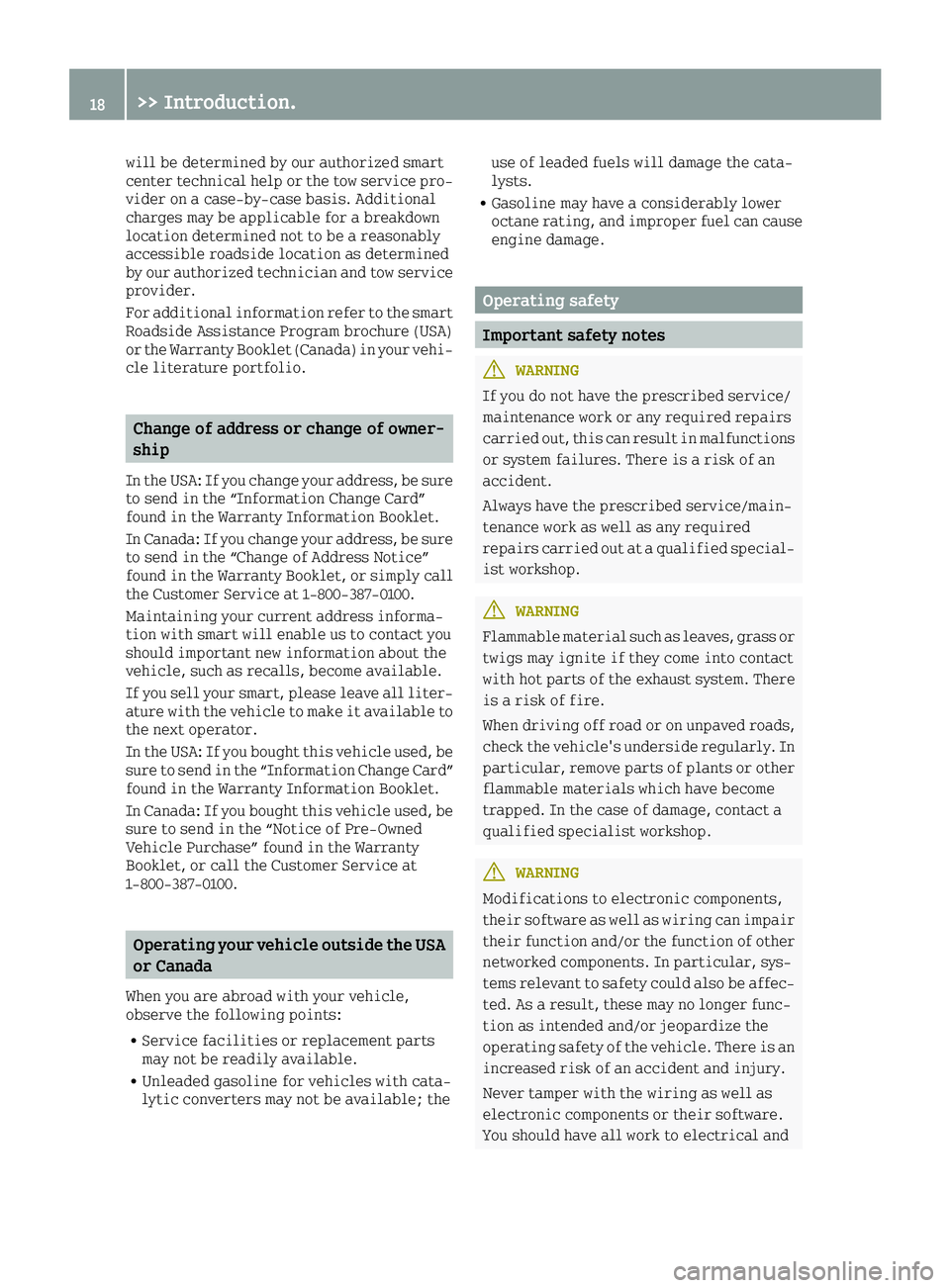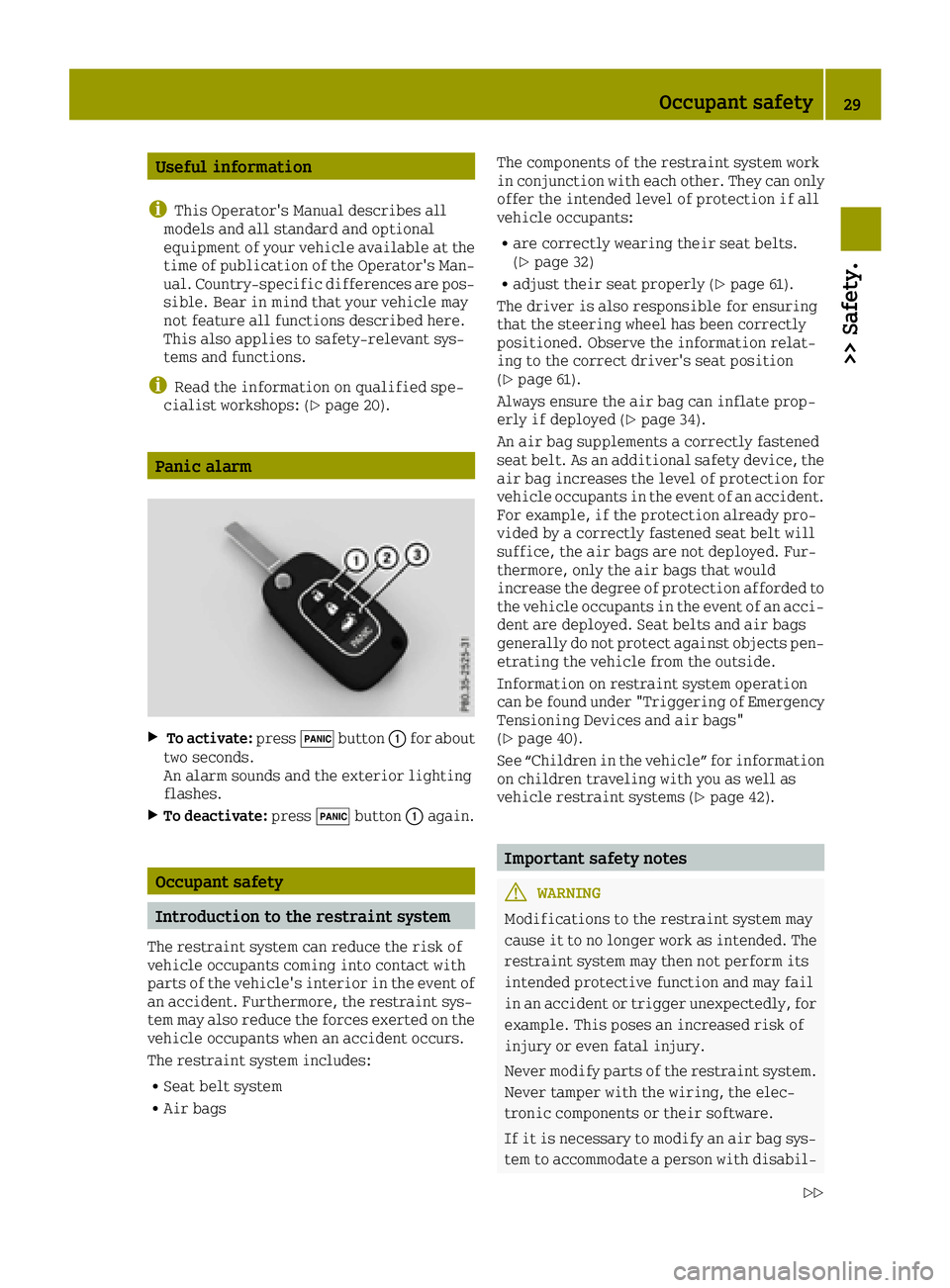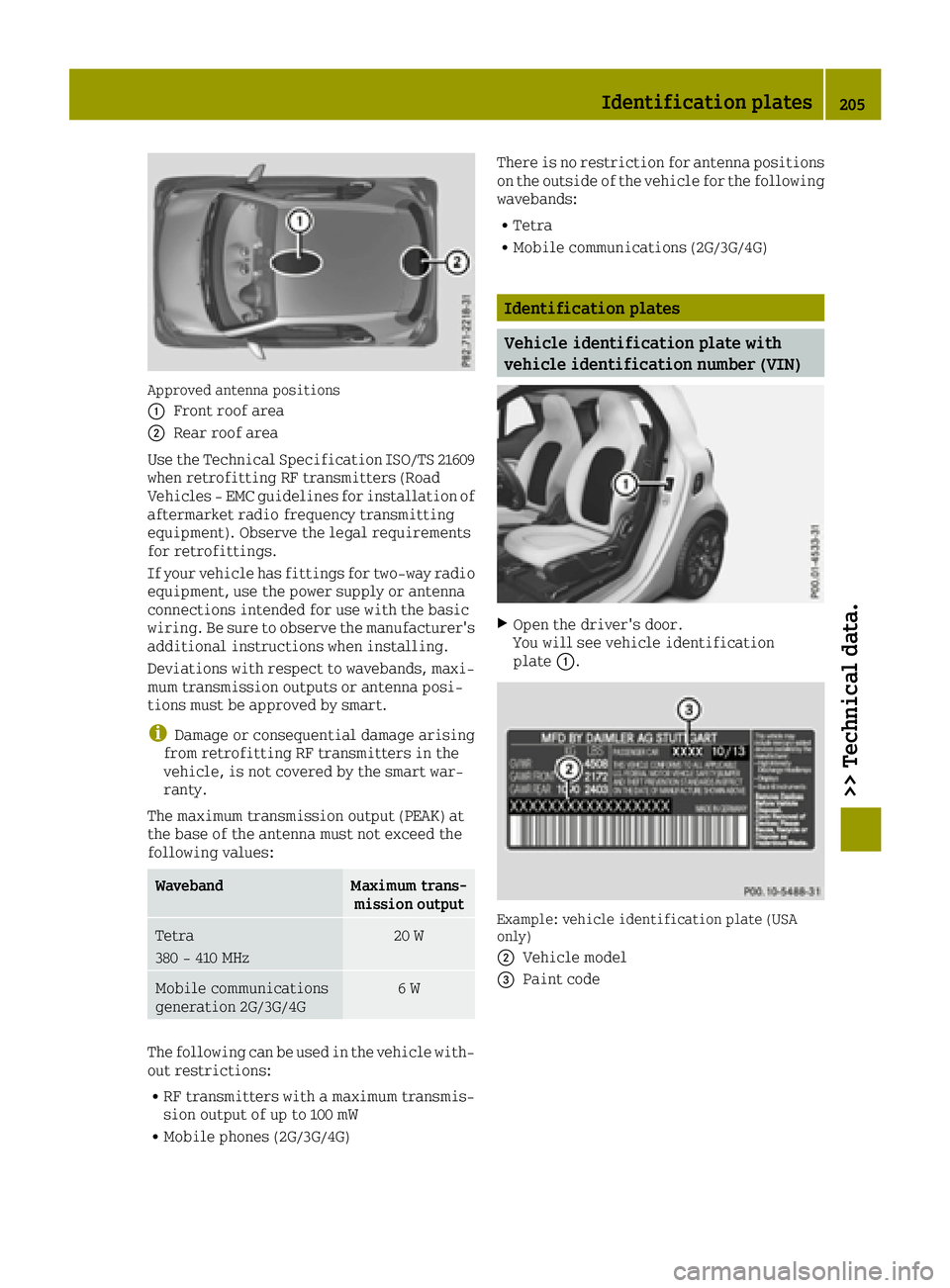wiring SMART FORTWO 2016 Owners Manual
[x] Cancel search | Manufacturer: SMART, Model Year: 2016, Model line: FORTWO, Model: SMART FORTWO 2016Pages: 214, PDF Size: 4.93 MB
Page 20 of 214

will be determined by our authorized smart
center technical help or the tow service pro-
vider on a case-by-case basis. Additional
charges may be applicable for a breakdown
location determined not to be a reasonably
accessible roadside location as determined
by our authorized technician and tow service
provider.
For additional information refer to the smart
Roadside Assistance Program brochure (USA)
or the Warranty Booklet (Canada) in your vehi-
cle literature portfolio.
Change of address or change of owner-
ship
In the USA: If you change your address, be sure
to send in the “Information Change Card”
found in the Warranty Information Booklet.
In Canada: If you change your address, be sure
to send in the “Change of Address Notice”
found in the Warranty Booklet, or simply call
the Customer Service at 1-800-387-0100.
Maintaining your current address informa-
tion with smart will enable us to contact you
should important new information about the
vehicle, such as recalls, become available.
If you sell your smart, please leave all liter- ature with the vehicle to make it available to
the next operator.
In the USA: If you bought this vehicle used, be
sure to send in the “Information Change Card”
found in the Warranty Information Booklet.
In Canada: If you bought this vehicle used, be
sure to send in the “Notice of Pre‑Owned
Vehicle Purchase” found in the Warranty
Booklet, or call the Customer Service at
1-800-387-0100.
Operating your vehicle outside the USA
or Canada
When you are abroad with your vehicle,
observe the following points:
RService facilities or replacement parts
may not be readily available.
RUnleaded gasoline for vehicles with cata-
lytic converters may not be available; the use of leaded fuels will damage the cata-
lysts.
RGasoline may have a considerably lower
octane rating, and improper fuel can cause
engine damage.
Operating safety
Important safety notes
GWARNING
If you do not have the prescribed service/
maintenance work or any required repairs
carried out, this can result in malfunctions or system failures. There is a risk of an
accident.
Always have the prescribed service/main-
tenance work as well as any required
repairs carried out at a qualified special-
ist workshop.
GWARNING
Flammable material such as leaves, grass or
twigs may ignite if they come into contact
with hot parts of the exhaust system. There
is a risk of fire.
When driving off road or on unpaved roads,
check the vehicle's underside regularly. In
particular, remove parts of plants or other
flammable materials which have become
trapped. In the case of damage, contact a
qualified specialist workshop.
GWARNING
Modifications to electronic components,
their software as well as wiring can impair
their function and/or the function of other
networked components. In particular, sys-
tems relevant to safety could also be affec-
ted. As a result, these may no longer func-
tion as intended and/or jeopardize the
operating safety of the vehicle. There is an increased risk of an accident and injury.
Never tamper with the wiring as well as
electronic components or their software.
You should have all work to electrical and
18>> Introduction.
Page 31 of 214

Useful information
i
This Operator's Manual describes all
models and all standard and optional
equipment of your vehicle available at the
time of publication of the Operator's Man- ual. Country-specific differences are pos-
sible. Bear in mind that your vehicle may
not feature all functions described here.
This also applies to safety-relevant sys-
tems and functions.
iRead the information on qualified spe-
cialist workshops: (Ypage 20).
Panic alarm
XTo activate: press0033button 0043for about
two seconds.
An alarm sounds and the exterior lighting
flashes.
XTo deactivate: press0033button 0043again.
Occupant safety
Introduction to the restraint system
The restraint system can reduce the risk of
vehicle occupants coming into contact with
parts of the vehicle's interior in the event of
an accident. Furthermore, the restraint sys-
tem may also reduce the forces exerted on the
vehicle occupants when an accident occurs.
The restraint system includes:
RSeat belt system
RAir bags The components of the restraint system work
in conjunction with each other. They can only
offer the intended level of protection if all
vehicle occupants:
Rare correctly wearing their seat belts.
(Ypage 32)
Radjust their seat properly (Ypage 61).
The driver is also responsible for ensuring
that the steering wheel has been correctly
positioned. Observe the information relat-
ing to the correct driver's seat position
(
Ypage 61).
Always ensure the air bag can inflate prop-
erly if deployed (
Ypage 34).
An air bag supplements a correctly fastened
seat belt. As an additional safety device, the
air bag increases the level of protection for
vehicle occupants in the event of an accident.
For example, if the protection already pro-
vided by a correctly fastened seat belt will
suffice, the air bags are not deployed. Fur-
thermore, only the air bags that would
increase the degree of protection afforded to
the vehicle occupants in the event of an acci-
dent are deployed. Seat belts and air bags
generally do not protect against objects pen-
etrating the vehicle from the outside.
Information on restraint system operation
can be found under "Triggering of Emergency
Tensioning Devices and air bags"
(
Ypage 40).
See “Children in the vehicle” for information on children traveling with you as well as
vehicle restraint systems (
Ypage 42).
Important safety notes
GWARNING
Modifications to the restraint system may
cause it to no longer work as intended. The
restraint system may then not perform its
intended protective function and may fail
in an accident or trigger unexpectedly, for
example. This poses an increased risk of
injury or even fatal injury.
Never modify parts of the restraint system. Never tamper with the wiring, the elec-
tronic components or their software.
If it is necessary to modify an air bag sys-
tem to accommodate a person with disabil-
Occupant safety29
>> Safety.
Z
Page 207 of 214

Approved antenna positions
0043
Front roof area
0044Rear roof area
Use the Technical Specification ISO/TS 21609
when retrofitting RF transmitters (Road
Vehicles - EMC guidelines for installation of
aftermarket radio frequency transmitting
equipment). Observe the legal requirements
for retrofittings.
If your vehicle has fittings for two-way radio
equipment, use the power supply or antenna
connections intended for use with the basic
wiring. Be sure to observe the manufacturer's additional instructions when installing.
Deviations with respect to wavebands, maxi-
mum transmission outputs or antenna posi-
tions must be approved by smart.
iDamage or consequential damage arising
from retrofitting RF transmitters in the
vehicle, is not covered by the smart war-
ranty.
The maximum transmission output (PEAK) at
the base of the antenna must not exceed the
following values:
WavebandMaximum trans- mission output
Tetra
380 - 410 MHz20 W
Mobile communications
generation 2G/3G/4G6 W
The following can be used in the vehicle with-
out restrictions:
RRF transmitters with a maximum transmis-
sion output of up to 100 mW
RMobile phones (2G/3G/4G) There is no restriction for antenna positions
on the outside of the vehicle for the following
wavebands:
RTetra
RMobile communications (2G/3G/4G)
Identification plates
Vehicle identification plate with
vehicle identification number (VIN)
XOpen the driver's door.
You will see vehicle identification
plate
0043.
Example: vehicle identification plate (USA
only)
0044
Vehicle model
0087Paint code
Identification plates205
>> Technical data.
Z